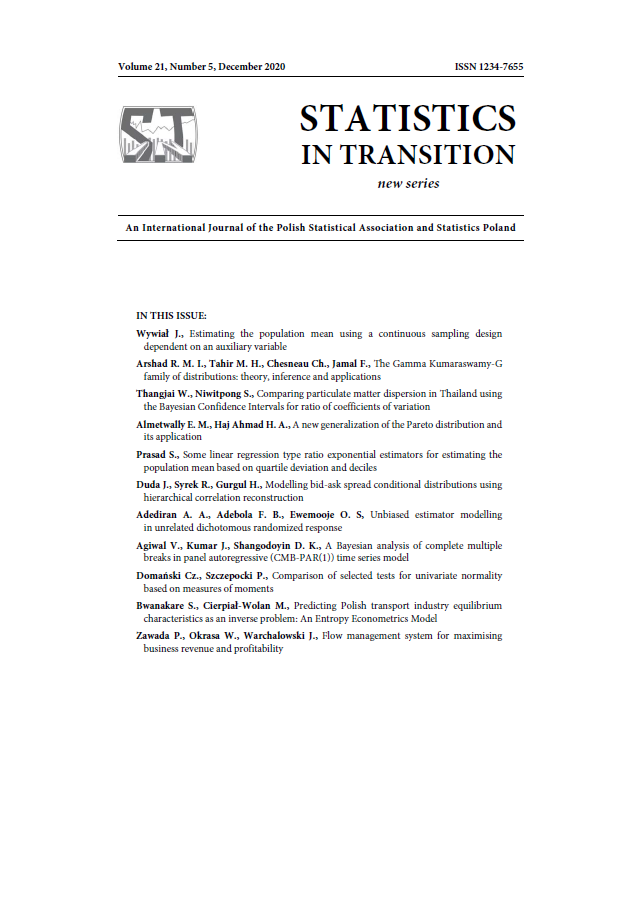ARTICLE
ABSTRACT
The unrelated design has been shown to improve the efficiency of a randomized response method and reduces respondents’ suspicion. In the light of this, the paper proposes a new Unrelated Randomized Response Model constructed by incorporating an unrelated question into the alternative unbiased estimator in the dichotomous randomized response model proposed by Ewemooje in 2019. An unbiased estimate and variance of the model are thus obtained. The variance of the proposed model decreases as the proportion of the sensitive attribute ?_A and the unrelated attribute ?_U increases, in contrast to the earlier Ewemooje model, whose variance increases as the proportion of the sensitive attribute increases. The relative efficiency of the proposed model over the earlier Ewemooje model decreases as ?_U increases when 0.1??_A? 0.3 and increases as ?_U increases when 0.35??_A? 0.45. Application of the proposed model also revealed its efficiency over the direct method in estimating the prevalence of examination malpractices among university students;the direct method gave an estimate of 19.0%, compared to the proposed method’s estimate of 23.0%. Hence, the proposed model is more efficient than the direct method and the earlier Ewemooje model as the proportion of people belonging to the sensitive attribute increases.
KEYWORDS
dichotomous, relative efficiency, sensitive attribute
REFERENCES
ADEBOLA, F. B., ADEPETUN, A. O., (2011). A new Tripartite Randomized Response Technique. Journal of the Nigerian Association of Mathematical Physics, 19, pp. 119–122.
ADEBOLA, F. B., ADEDIRAN, A. A., EWEMOOJE, O. S., (2017). Hybrid tripartite randomized response technique. Communications in Statistics-Theory and Methods, 46(23), pp. 11756–11763; https://doi.org/10.1080/03610926.2016.1277760 .
COBO, B., RUEDA, M. M., LÓPEZ –TORRECILLAS, F., (2016). Application of randomized response techniques for investigating cannabis use by Spanish university students, International Journal of Methods in Psychiatric Research; https://doi.org/10.1002/mpr.1517 .
EWEMOOJE, O. S., (2017). Estimating two sensitive characters with equal probabilities of protection, Cogent Mathematics, 4, pp. 1–14.
EWEMOOJE, O. S., ADEBOLA, F. B., AMAHIA, G. N., (2019a). Alternative Unbiased Estimator in Dichotomous Randomized Response Technique, Communication in Mathematics and Statistics, 7(4), pp. 383–400; https://doi.org/10.1007/s40304-018- 0145-x.
EWEMOOJE, O. S., ADEBOLA, F. B., ADEDIRAN, A. A., (2018). A Stratified Hybrid Tripartite Randomized Response Technique, Gazi University Journal of Science, 31(4), pp. 1246–1266.
EWEMOOJE O. S., ADEBOLA, F. B., AWOGBEMILA, A. T., (2019b). Substance Use disorder prevalence using tripartite randomized technique, 14(1), pp. 55–61. https://dx.doi.org/10.4314/njtr.v14i1.8 .
EWEMOOJE, O. S., AMAHIA, G. N., ADEBOLA, F. B., (2017). Estimating prevalence of induced abortion and multiple sexual partners using improved randomized response technique for two sensitive attributes, Communications in Statistics: Case Studies, Data Analysis and Applications, 3(1-2), pp. 21–28; https://doi.org/10.1080/23737484.2017.1398057 .
FOX, J-P., VEEN, D., KLOTZKE K., (2019). Generalized Linear Mixed Models for Randomized Responses, Methodology (2019), 15(1), pp. 1–18; https://doi.org/10.1027/1614-2241/a000153 .
GREENBERG, B., ABUL-ELA, A., SIMMONS, W., HORVITZ, D., (1969). The Unrelated question Randomized Response Technique: Theoretical framework, Journal of American Statistical Association, 64, pp. 529–539.
HOGLINGER, M., JANN, B., (2018). More is not always better: An experimental individual-level validation of the randomized response technique and the crosswise model, PLoS ONE 13(8): e0201770; https://doi.org/10.1371/journal.pone.0201770 .
HORVITZ, D. G., SHAH, B. V., SIMMONS, W. R., (1967). The unrelated question Randomized Response Technique, Proceedings of social statistical section American Statistical Association, pp. 65–72.
HUSSAIN, Z., SHABBIR, J., (2007). Randomized use of Warner’s randomized response Technique, Interstat: April #7. http://interstat.statjournals.net/INDEX/Apro7.html
JANN, B., JERKE, J., KRUMPAL, I., (2012). Asking sensitive question using the crosswise model, an experimental survey measuring plagiarism. Public Opinion Quarterly, 76, pp. 32–49; https://doi.org/10.1093/poq/nfr036 .
MANGAT, N. S., SINGH, R., (1990). An alternative randomized response procedure, Biometrika, 77, pp. 439–442.
WARNER, S. L., (1965 . Randomized response: a survey technique for eliminating evasive answers bias, Journal of the American Statistical Association, 60, pp. 63–69.
YU, J.-W.., TIAN, G.-L., TANG, M.-L., (2008). Two new models for survey sampling with sensitive characteristic; design and analysis. Metrika, 67, pp. 251–263; https://doi.org/10.1007/s00184-007-0131-x .
